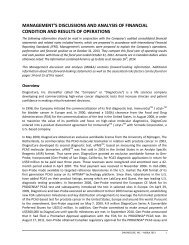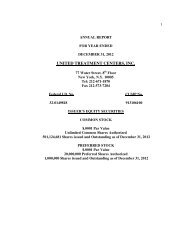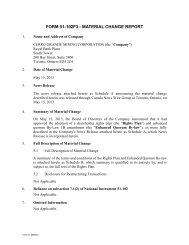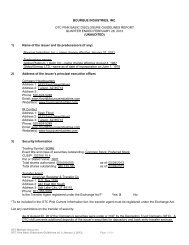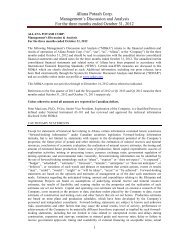ANNUAL INFORMATION FORM ENDEAVOUR MINING CORPORATION
ANNUAL INFORMATION FORM ENDEAVOUR MINING CORPORATION
ANNUAL INFORMATION FORM ENDEAVOUR MINING CORPORATION
Create successful ePaper yourself
Turn your PDF publications into a flip-book with our unique Google optimized e-Paper software.
gold-pyrite mineralization. There is no significant component of refractory gold in the sulphide<br />
zone at Adamus. The surface projection of identified mineralization trends northwest for<br />
approximately 900m and is up to 400m wide. Within this zone there are seven distinct domains<br />
of varying orientation and style that were used for the resource estimation.<br />
The Bokrobo deposit comprises generally north-south trending, steeply west dipping auriferous<br />
quartz veins hosted by strongly silica and iron carbonate altered, medium to coarse grained,<br />
carbonaceous greywacke. A north-south trending dolerite dyke, dipping sub-vertically to the<br />
west cuts the depth extension of the main vein. In the southern portion of the deposit, a westnorthwest<br />
to east-southeast trending, steeply south-southeast plunging ‘dyke-like’ granitic<br />
intrusion is cut by numerous auriferous quartz veins forming a sheeted vein system. In the north<br />
of the deposit, mineralization generally occurs in a single lode, but in the south, the<br />
mineralization occurs as two main lodes and a series of narrow stacked lodes around or in the<br />
outer margins of the granite intrusion.<br />
Akropon mineralization occurs within a wide zone of silicification associated with pyrite and<br />
quartz veining with sericite as an accessory alteration mineral. The difference between the<br />
apparent dip of the mineralization and bedding suggests an en echelon vein array or possibly<br />
complex veining across a fold closure. Very little arsenopyrite has been identified at Akropon<br />
and the mineralization in other deposits in this area are non-refractory, but metallurgical testing<br />
is required.<br />
At Nfutu mineralization occurs within quartz-pyrite veins and pyrite disseminations, typically<br />
around veins, in the host rocks with silica, iron carbonate and sericite as the major alteration<br />
minerals. Multiple flat-lying to shallowly east dipping and southeast plunging lodes occur as<br />
stacked lenses that appear to thicken with depth. Mineralization is more prominent at the<br />
graphitic phyllite-greywacke contact than in the competent greywacke. Only traces of<br />
arsenopyrite were identified in drill core, and preliminary metallurgy shows that mineralization<br />
is non-refractory.<br />
At Aliva mineralization occurs as a series of stacked, shallowly east-dipping lenses subparallel to<br />
the east dipping contact between carbonaceous phyllite footwall and greywacke hangingwall.<br />
Mineralization appears to wrap around gentle to open folds and is associated with quartz veins<br />
with sericite alteration and pyrite disseminations in the veins and surrounding host rocks. No<br />
arsenopyrite has been identified at Aliva and the mineralization in other deposits in this area are<br />
non-refractory. Metallurgical testwork on 76 samples of all material types returned over 90%<br />
recovery.<br />
At Avrebo the gold mineralization occurs in north-south to northeast-southwest trending,<br />
subvertical to steeply east-dipping, strongly sericite-iron carbonate altered lodes within<br />
metabasalt. Pyrite has been the only sulphide identified to date suggesting that the sulphide<br />
gold component may be non-refractory. Metallurgical tests have not yet been completed.<br />
14



